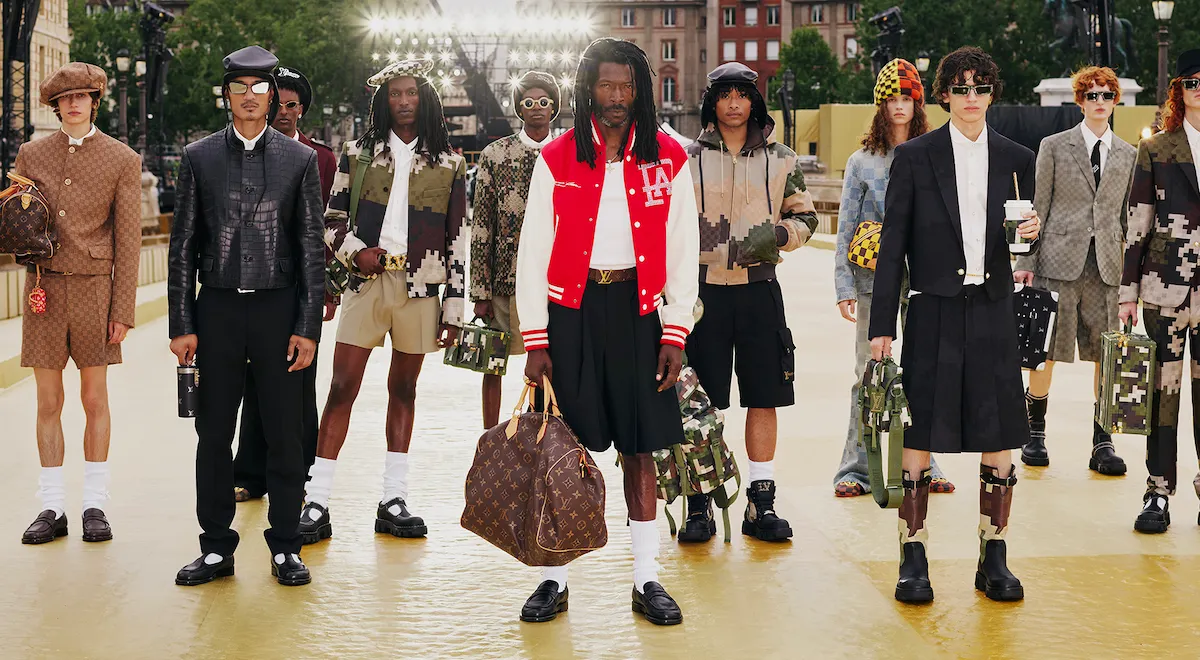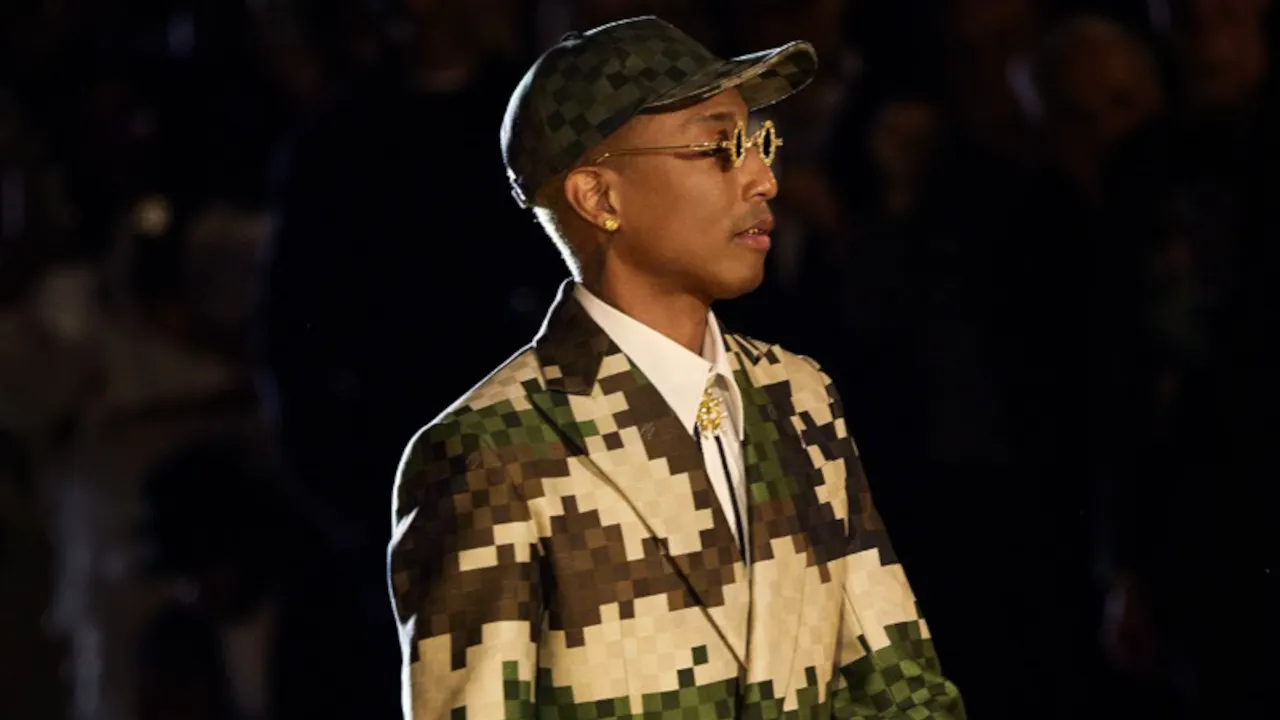Bad World is an occasional column by Toni Thai Sterrett, a filmmaker, futurist, and founder focused on the intersection of fashion and technology.
Welcome to the Bad World, where we embrace the future of fashion in all of its elements. At the moment, the conversation around sustainability is the loudest. We can talk about a more sustainable world without having to sacrifice individuality, style, and pleasure. We just talk about it in a real and authentic way.
Now let's dive into something I love: Pharrell Williams’ 2023 appointment as the new Creative Director at Louis Vuitton and his debut collection for the brand’s 2024 Men's Spring/Summer collection. But before I dig into that, I’m drawn back to the excitement in the air when Louis Vuitton released its first NFT, a soulbound token—meaning it can’t be traded or sold—in early June 2023.
This Louis Vuitton drop was fascinating for many reasons. One, we talk a lot about NFTs making it easier for brands to have loyalty programs for their customers, á la Starbucks and Nike. But a soulbound token makes it a two-way street, introducing a reciprocal kind of brand loyalty.
It’s community. It’s an exchange. By showing loyalty to the brand, they’ll reward you with lots of goodies for your faith in them—a lovely move by LV. And two, everyone is saying NFTs are dead, but clearly they’re not and the excitement amongst fashion aficionados was palpable.
Last year, Pharrell Williams was named Chief Brand Officer of NFT project Doodles. And in April 2023, Doodles released the Pharrell Pack, which grants NFT holders access to digital wearables customized by Williams and his brands. This is a move towards creating a world that rewards community engagement while bridging IP and social identity through the limited edition release of 300 packs of limited edition digital wearables.
Williams’ foray into the NFT space clearly places him in the future of fashion. I’d even say, Pharrell Williams is the future of fashion. Quote me but don’t debate me. I have receipts, hold tight.
When the Valentine's Day 2023 news dropped of Williams’ appointment as the new Creative Director of Louis Vuitton, taking over for the late, great Virgil Abloh—who sadly passed away in November 2021—there was much applause amid rumblings of hate.
There were some screams and moans from people who felt the job would've been better suited for a more “established” designer, paired with lamentations about him not having a formal fashion education. But neither did Abloh, whose vision and work was widely praised.
At Louis Vuiton (and his own Off-White brand), Abloh redefined streetwear and ushered in a new, boundary-pushing and exciting era of menswear. Abloh had degrees in Civil Engineering and Architecture—degrees earned while Pharrell was making us dance.
Williams’ “education” was informal, coming courtesy of the likes of Nigo, the Japanese fashion designer best known as the creator of the urban clothing line, A Bathing Ape. Nigo is currently the creative director for Kenzo, with whom Williams launched the wildly successful Billionaire Boys Club and Ice Cream brands. To many, menswear has never really been that exciting to the public; now these shows are getting just as much press and attention as the women's shows.

Art and all forms of creativity collide, and we are better for it. Williams, like Abloh, helped redefine “masculine expression,” pushed boundaries and gender norms, and allowed men the ability to be more expressive in their style choices. It’s hard to argue against the fact that the qualifications for being a Creative Director are just that you’re well-rounded, open, and creative AF. Williams has proven that his creativity knows no bounds.
Williams has often spoken about how much he learned from Karl Lagerfeld, as well as Francesco Ragazzi of Palm Angels and Colette founder Sarah Andelman. He boasts a long-running relationship with Adidas on the design side, and a number of successful collabs with luxury labels such as Chanel, Moncler, Tiffany’s, and Moynat. And don’t forget his first collab with Louis Vuitton thanks to Marc Jacobs, back in 2004. These are receipts, friends.
And speaking of Jacobs, he made his own interesting entry into the future of fashion conversation during his Fall 2023 runway show at the New York Public Library, where he presented 29 looks in no more than three minutes. He seemingly embraced AI technology by having his show notes written entirely by ChatGPT.
In a subtle statement about sustainability, Jacobs presented a collection of timeless and impeccably tailored suits designed for women, predominantly in black and white. The collection evoked many eras of fashion while being versatile and elegant; statement pieces that one can have in their wardrobe for many years to come. This matter, given the growing conversation around owning less and fashion being less wasteful and more environmentally friendly.
We can’t talk about sustainability and not highlight the fact that Williams was thinking about all of this years ago. Sustainability was the focus of his 2017 collaboration with G-Star Raw, when they released a collection that saw plastic recycled into denim, which reduced waste and cut down the negative impact that fashion has on the environment.
Now taking a look at his debut for Louis Vutton’s Fall/Winter 2024 collection, Williams’ point of view was clear. It felt foundational with very appropriate nods to hip-hop culture, which was appropriate given that this year marks the 50th anniversary of the art form.
Men's Spring-Summer 2024 Show. Infused with a welcoming optimism, the debut collection of @Pharrell evoked a contrasting heritage savoir-faire with a trailblazing vision. Watch the full show at https://t.co/PvrcFe0O8w#LVMenSS24 #LouisVuitton #PharrellWilliams pic.twitter.com/RCjPUf13gb
— Louis Vuitton (@LouisVuitton) June 21, 2023
The Yankees-inspired colorway for his jacket was a nod to NYC street style, and possibly also to his longtime friend and collaborator Jay-Z, who closed the show and was famously known to always rock a Yankees fitted hat. It was classy and classic with a little “street”—clean and tapered, and the collection appeared to keep in mind all of Louis Vuitton's customers and fans while remaining consistent throughout. That couldn’t have been an easy feat.
The choir and orchestra that heightened the epic vibe of Williams’ debut Louis Vuitton show can also be taken as a nod to Pyer Moss designer and founder Kerby Jean-Raymond, whose legacy was, by some accounts, obliterated by The Cut.
But at the height of Jean-Raymond’s popularity, when he was the darling of the fashion industry, models marched out to the sounds of his 90-member choir called “The Pyer Moss Tabernacle Drip Choir Drenched in the Blood,” as they belted out a beautiful medley of medley gospel, soul, hip-hop, and R&B music to keen observers of the culture (OK, me).
“Pyer Moss Tabernacle Drip Choir Drenched in The Blood.”
https://t.co/meTJfQuc81 pic.twitter.com/dtkYSanCnG— HYPEBEAST (@HYPEBEAST) September 9, 2019
It was perhaps Williams’ way of saying, “We still see you Kerby.”
One off-the-mark critique after the collection dropped was that the pixel print that Williams has dubbed “Damouflage”—i.e. LV’s classic Damier print used to create a camouflage-like print—was copied from Loewe’s recent collection. But in fact, Pharrell’s Billionaires Boys Club produced pixel and camouflage-inspired prints in the past. Additionally, Louis Vuitton released a pixel collection in 2018 when Kim Jones was Creative Director.
Web3 loyalists wondered aloud if the use of the pixel print was another perceived nod to his NFT “frens” á la the pixelated CryptoPunks—an NFT project that, like Williams, also scored a pivotal Tiffany’s collaboration as part of the luxury brand’s move into the future.
Men's Spring-Summer 2024 Show. @KimKardashian attended @Pharrell's debut presentation on the iconic Pont Neuf Bridge in Paris. Watch the full show at https://t.co/R5kjZkf7S7#LVMenSS24 #LouisVuitton #PharrellWilliams pic.twitter.com/ZcvhAc5xXy
— Louis Vuitton (@LouisVuitton) June 22, 2023
This nod could be wishful thinking, but Web3-native fashion brands like The Fabricant are still progressing “bullishly”—moving forward with extreme confidence—in the NFT space, inspired by the recent Web3 moves by major brands like Louis Vuitton, Nike, Lacoste, and many others who are showing that they are likewise “bullish” on taking risks.
Last month, I spoke on a panel at NFC Lisbon titled, “Does digital fashion need Web3?” And I argued that it does not—at least not right now, because we are quite a ways away from mass adoption.
It takes a lot of time and a whole lot of money to change consumer behavior, but the brands taking these chances and embracing technology will be at the forefront in the future. As seen by Williams, Louis Vuitton’s parent company LVMH, and even Marc Jacobs, there is a paradigm shift—one that promises a future in which fashion is at times accessible, can be ethically produced, fun, and digitally empowered with love.
In Williams’ debut for Louis Vuitton, he gave a nod to his hometown of Virginia Beach by turning the “LV” into somewhat of an acronym for “LoVers,” riffing on Virginia’s tagline of “Virginia is for Lovers.” Love never dies, so let’s remain “bullish” on love. RIP Virgil Abloh.
